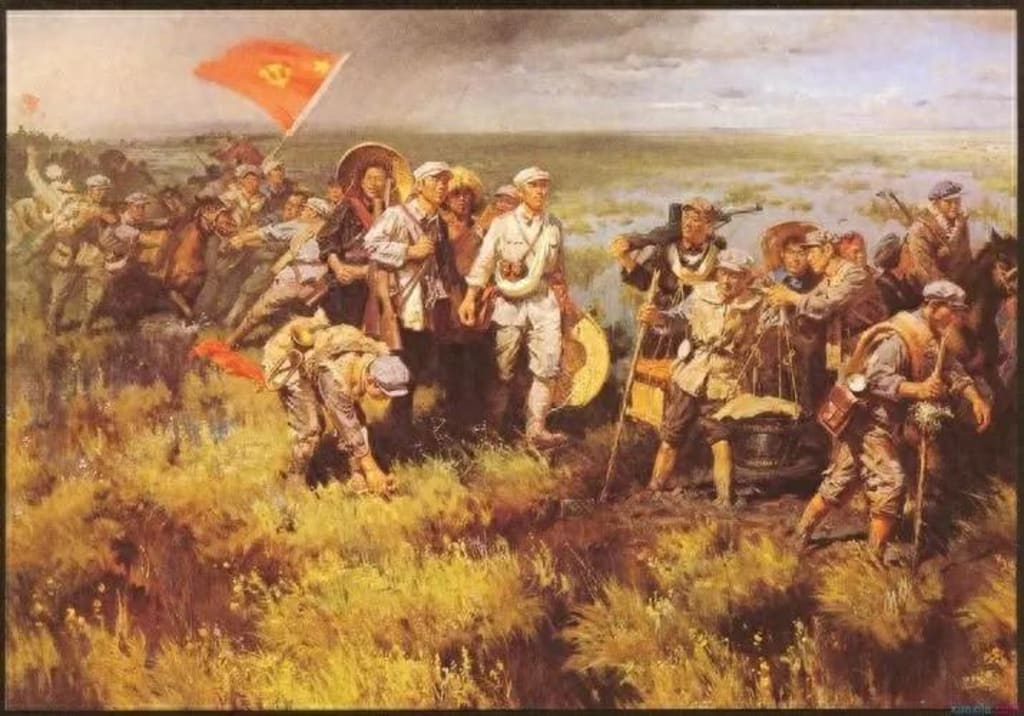More than 80 years have passed, how is that "cannibalistic" grassland from the Red Army's Long March now?
ahong

The Long March of the Red Army was extremely arduous, filled with the breath of danger everywhere.
Especially that cannibalistic Songpan grassland, in the seemingly ordinary grassland, there are actually swamps everywhere, and if you are not careful, you will fall into the mud, which can be described as difficult to move.
But the Red Army soldiers relied on their tenacious willpower and the belief that they must overcome all difficulties, and step by step, they walked out of this hellish grassland.
Now more than 80 years have passed since the Long March, how is that "cannibalistic" grassland now?
Climbing mountains and ridges, it is difficult to take a step
In 1934, the Central Red Army was forced to make a strategic transfer, and thus, the unforgettable Long March began.
For more than two years, the Red Army soldiers walked 25,000 miles of mountains and grasslands on foot, in an environment where there were chasing troops behind, mountains and rivers ahead, and food was scarce, how difficult it was.
At that time, the Red Army not only had insufficient food, but also the clothes they wore were very scarce. Sometimes when they were exhausted, there was no suitable place to rest.
Continuously moving made their physical strength quickly run out, but there was no food to replenish their strength. Moreover, the long-term wind and sun exposure and uncertain heavy rain attacks made every step they took rely on the will in their hearts.
Due to the situation, the route of the Red Army's Long March included turbulent rivers, steep snow-capped mountains, endless grasslands, and swamps. These rugged roads brought a lot of trouble to the Red Army's marching speed.
Moreover, there were enemies chasing behind, facing the enemy's siege and interception, the Red Army had to break through in different directions, using the complex and difficult terrain to evade the pursuit.
Food supply was also a big problem. Originally, the Red Army's food was relatively scarce, and this time it was a forced march, and they had to evade the enemy, so they couldn't bring too much food. They had to obtain some food from the local area, but due to the harsh environment, it was not easy to obtain edible food in the wild.
Moreover, there were no obvious road signs on the road, and the terrain was very complex and diverse. They walked and walked and lost their way. In such a harsh environment, without food and water, many soldiers did not make it to the end and fell down.
There were also extreme weather changes. The places they passed were desolate, and the temperature difference between day and night was very large. The Red Army soldiers were mostly dressed in thin clothes, and they had to endure the piercing cold while their physical strength was not supplemented.
The most impressive thing is still the Songpan grassland. It seems to be a vast and flat grassland with a wide road, but in fact, it is full of swamps. The Red Army took 7 days to pass through this grassland, but the price paid was huge and tragic.
So, what kind of crisis is hidden in this "cannibalistic" grassland of Songfan?
"Cannibalistic" grassland
"The sky is vast and the grass is endless, the wind blows the grass low to see the cattle and sheep." The beauty of the grassland is something many people yearn for, and many people want to gallop on the endless grassland.
The grassland in our mind is full of cattle and sheep, and it is boundless. However, there is such a grassland in our country that has caused countless people to lose their lives here.
It is the Songfan grassland located in Sichuan Province. If you stand here and look at this grassland, you will definitely think that it looks no different from other grasslands, all green.
But such an unremarkable grassland has a chilling killing intent inside. If you accidentally enter this area, you may be swallowed by it if you are not careful.
We all know that during the Long March of the Red Army, there were many difficulties such as climbing snow-capped mountains, crossing grasslands, crossing the Chishui River four times, and seizing the Luding Bridge. However, few people know what kind of fear the Red Army soldiers experienced in this Songfan grassland.
On this seemingly flat grassland, there are endless swamps underneath, and the climate here is unpredictable. The dead and silent environment is shrouded in fog all year round, making it difficult to distinguish the direction ahead, and a wrong step may fall into the bottomless mud. Once you fall in, it is very difficult to get out.
Moreover, the weather in the Songfan grassland is unpredictable. It may suddenly rain heavily at any time, and on the grassland, the Red Army soldiers have no shelter and can only let the heavy rain erode their bodies. Even many young soldiers with good physical fitness were damaged by the heavy rain.
In addition, the food was very scarce at that time, and the marching speed of the Red Army soldiers in this desolate swamp was greatly reduced. In order to fill their stomachs, they could only eat the wild grass on the ground, and some even ate the leather belt.
Many soldiers were already plagued by illness, and the unsanitary wild grass and leather belt made the Red Army soldiers vomit and have diarrhea. The endless swamp, the shortage of food, and the heavy rain attack, many soldiers stayed in this grassland forever.
Time has passed
So, after more than 80 years, what is the scene of this grassland now?
After the establishment of New China, the country began to manage this cannibalistic grassland. According to the memories of the old soldiers who experienced the Long March, experts analyzed this grassland and determined that the biggest problem of the Songfan grassland is the water accumulation problem.
There is a rich water resource under this vast grassland, but a large amount of water gathers underground here and has no place to stay, forming swamps. To eliminate this swamp, the water must be drained first.
In order to drain the water here, it is necessary to build a drainage ditch to guide the water out. After discussion, the experts decided to build a drainage ditch underground, fundamentally solving the drainage problem.
In addition to drainage, experts also mobilized local herdsmen to adjust the agricultural structure of this grassland. Planting crops can better absorb groundwater and better protect the underground land resources, making this land more solid.
After so many years of ecological restoration of this grassland, the Songfan grassland has already been completely new, and the former swamp has now become a real flat grassland.
The grassland and farmland are combined, and now it is full of vitality, with the wind blowing the grass low and cattle and sheep everywhere.
Through continuous protection and development, it has also become a tourist attraction, and countless tourists come here to see the style of Songfan, and the beautiful natural scenery is refreshing, with rich resources, and many people have chosen to settle here after coming here.
In order to commemorate the Red Army soldiers who sacrificed here, the Red Army Long March Monument Park was also established and has become a red tourist attraction.
Conclusion
The Songpan grassland is an extremely difficult pass in the process of the Red Army's Long March. This grassland carries the dreams of countless Red Army soldiers. Nearly 90 years have passed, and the once green "death trap" no longer exists, replaced by a beautiful scenery.
And here, it has also become an important place for people to recall history and remember the martyrs. Every Red Army soldier who walked on the Songpan grassland will never be forgotten, and the spirit of the Red Army's hard struggle will be passed down forever.
The later management of the Songfan grassland not only shows the rapid progress of our country after the establishment of New China but also highlights the happier life of the Chinese people and reflects the Chinese people's awe for their ancestors.
This grassland has witnessed the development of history and is a symbol of the Chinese people's struggle. Now, the thriving prosperity also comforts the ancestors who sleep on this grassland.
In the future, we must not only protect this prosperity but also manage this grassland better.
About the Creator
ahong
I'm Ahong, a writer painting China's stories for the world. Dive into tales that blend tradition with the contemporary, right from the heart of China.
Enjoyed the story? Support the Creator.
Subscribe for free to receive all their stories in your feed. You could also pledge your support or give them a one-off tip, letting them know you appreciate their work.






Comments
There are no comments for this story
Be the first to respond and start the conversation.